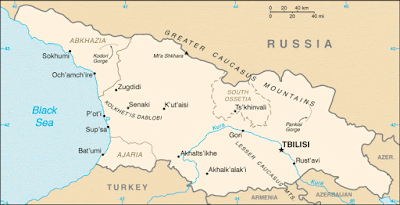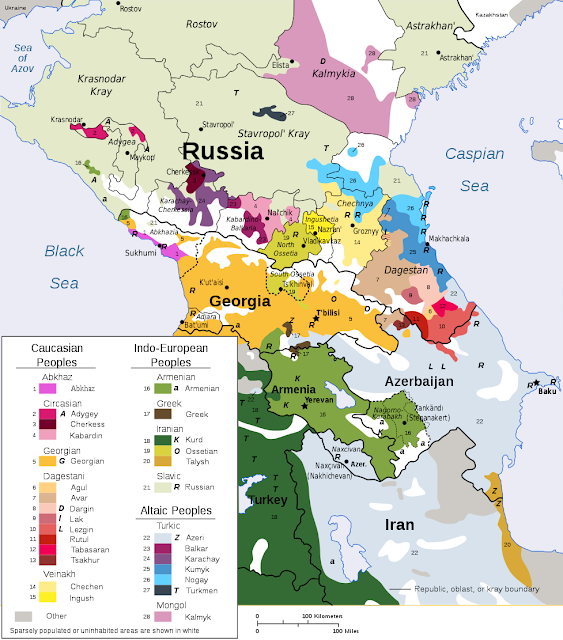By Kathryn Butterworth
The Republic of Georgia on the Eastern rim of Europe is unique in its language and dialect diversity, in addition to being home to many minorities and minority languages. With a population of about 4 million, Georgia is home to more than a dozen languages. The official state language is Georgian. It is a literary and written language shared by multiple subgroups of other languages like Svans, Mingrelians and Laz that belong to the same group of Kartvelian languages as Georgian. The other ethnic groups in the country include Azeris, Armenians, Russians, Ossetians Yazdis, Ukrainians, Kists, and Greeks.
The country’s multilingualism is largely a result of its history that evolved from disparate kingdoms first united under Bagrat III into a single state in 1008. A successor state of the Soviet Union, Georgia has been an independent state since 1999 and a member of the Council of Europe. It is home to sizable immigrant communities and multiple dialects within its own borders, but Georgian remains the sole official language of the state. When Georgia joined the Council of Europe in 1999, the state’s historically homogenous approach to language policy appeared to have been counteracted by its willingness to sign the European Charter for Regional or Minority Languages (ECRML). However, unlike neighboring successor states like Armenia that signed and ratified the ECRML in 2002, Georgia has not ratified the Charter to protect its unique linguistic diversity in coordination and consultation with the Council of Europe.
Historically, Georgia has always been at the crossroads of great empires. It was dominated by Persians, Arabs, Turks, and most recently by the Soviet Union. In addition to dialectal diversity arising from these historical contexts, Georgia is also geographically situated in a linguistically and ethnically rich and distinctive region in the Caucasus. The country borders Russia to its north (specifically the North Caucasus region of Russia), and Armenia and Azerbaijan to its south and southeast.
North Caucasian languages are equally if not more linguistically diverse. The Caucasus are a mountainous region. Indeed the North Caucasian mountain range serves as a natural border, also called isogloss, between languages of the North and South Caucasus. Georgian is the largest language in the Kartvelian language group, alongside Svan (largely located in the Svaneti (სვანეთი) region of Georgia in the northwest), Mingrelian (Samegrelo (სამეგრელო) region in the southwest of the country near Abkhazia) and Laz (a language primarily found in the West of Georgia and also in parts of Turkey). These languages are spoken in conjunction with Standard Georgian and speakers of Svan, Laz and Mingrelian are considered ethnic Georgians despite the fact that their spoken language is different than standard spoken Georgian and is not always mutually comprehensible. In other words, if one only understands Georgian, one will not necessarily understand Laz. Below is a map depicting the ethno-linguistic complexity of the North and South Caucasus, as described above.
As the map illustrates, the region is home to languages within the Indo-European language group in addition to Kartvelian and North Caucasian languages. Dialects of the Georgian language itself vary regionally and this is a common phenomenon shared with most states which have a degree of ethnic and geographic heterogeneity. In the Republic of Georgia, these dialects are generally segregated by an East/West division. Due to the mountainous topography of Georgia’s north and northwest region, many of these dialects result from seclusion in which the Georgian language has been molded over time. In the East, the two main dialects of Georgian are Kakhetian (located in the Kakheti region) and Kartlian.
Georgian has its own alphabet: the so-called Georgian script. It has its origins in the foundations of Orthodox Christianity in Georgia from 337 onward. Later, the three historical alphabets have evolved into a single one, the so-called Mkhedruli alphabet that was originally used for secular, unofficial writing. Later it expanded and was popularized in commerce and trade. According to Omniglot, the first dictionary of Georgia was a Georgian-Italian dictionary written with the Mkhedruli script and published in 1629 in Rome, Italy. Today, this script is the sole alphabet used to write Georgian.
The Georgian language moved through traditional stages such as low, middle and high Georgian and eventually developed into the form we see today. The language is known for its complexity, both in its verbal system as well in its pronunciation. This is to say that while Georgian has a phonetic alphabet, it is notorious for its consonant clusters, rendering it difficult to pronounce in the beginning stages of learning.
While Georgian is in its own distinct language group different from Slavic or Indo-European languages and has a distinct culture, it lays claim to simultaneously being a part of and apart from Europe. Though sharing a cultural history with Europe, primarily rooted in Christianity, Georgia also envisions itself as a crossroads between East and West with a distinct history and culture. This tension between a type of modernity associated with the West, and a strong need to preserve traditional Georgian culture and language norms may help explain the lack of real commitment to the European Charter for Regional or Minority Languages. It is, interestingly enough, quite obvious in the linguistic landscape – including road signs – throughout Georgia.
References
World Heritage Encyclopedia. ‘Kartvelian Languages.’
http://www.gutenberg.us/articles/eng/Kartvelian_languages, accessed 4-8, 2017.
Kobaidze, Kock Manana (2004-02-11) From the history of Standard Georgian Archived September 27, 2007, at the Wayback Machine
Resources for the Study of the Georgian language, University of Illinois Library, http://guides.library.illinois.edu/c.php?g=347564&p=2344201, accessed 4-8 2017
OMNIGLOT: the Online Encyclopedia of Writing Systems and Languages: Georgian, https://www.omniglot.com/writing/georgian.htm
---
Kathryn Butterworth was a graduate student pursuing a Master of Science in Library and Information Science at the iSchool when she wrote this text in 418, ‘Language and Minorities in Europe’ in spring 2017.
The Republic of Georgia on the Eastern rim of Europe is unique in its language and dialect diversity, in addition to being home to many minorities and minority languages. With a population of about 4 million, Georgia is home to more than a dozen languages. The official state language is Georgian. It is a literary and written language shared by multiple subgroups of other languages like Svans, Mingrelians and Laz that belong to the same group of Kartvelian languages as Georgian. The other ethnic groups in the country include Azeris, Armenians, Russians, Ossetians Yazdis, Ukrainians, Kists, and Greeks.
The country’s multilingualism is largely a result of its history that evolved from disparate kingdoms first united under Bagrat III into a single state in 1008. A successor state of the Soviet Union, Georgia has been an independent state since 1999 and a member of the Council of Europe. It is home to sizable immigrant communities and multiple dialects within its own borders, but Georgian remains the sole official language of the state. When Georgia joined the Council of Europe in 1999, the state’s historically homogenous approach to language policy appeared to have been counteracted by its willingness to sign the European Charter for Regional or Minority Languages (ECRML). However, unlike neighboring successor states like Armenia that signed and ratified the ECRML in 2002, Georgia has not ratified the Charter to protect its unique linguistic diversity in coordination and consultation with the Council of Europe.
 |
| Map of Georgia (Image Source) |
North Caucasian languages are equally if not more linguistically diverse. The Caucasus are a mountainous region. Indeed the North Caucasian mountain range serves as a natural border, also called isogloss, between languages of the North and South Caucasus. Georgian is the largest language in the Kartvelian language group, alongside Svan (largely located in the Svaneti (სვანეთი) region of Georgia in the northwest), Mingrelian (Samegrelo (სამეგრელო) region in the southwest of the country near Abkhazia) and Laz (a language primarily found in the West of Georgia and also in parts of Turkey). These languages are spoken in conjunction with Standard Georgian and speakers of Svan, Laz and Mingrelian are considered ethnic Georgians despite the fact that their spoken language is different than standard spoken Georgian and is not always mutually comprehensible. In other words, if one only understands Georgian, one will not necessarily understand Laz. Below is a map depicting the ethno-linguistic complexity of the North and South Caucasus, as described above.
 |
| Language diffusion map (Image Source) |
 |
| A screenshot of the Mkhedruli Georgian alphabet, from this guide to Georgian alphabets |
The Georgian language moved through traditional stages such as low, middle and high Georgian and eventually developed into the form we see today. The language is known for its complexity, both in its verbal system as well in its pronunciation. This is to say that while Georgian has a phonetic alphabet, it is notorious for its consonant clusters, rendering it difficult to pronounce in the beginning stages of learning.
While Georgian is in its own distinct language group different from Slavic or Indo-European languages and has a distinct culture, it lays claim to simultaneously being a part of and apart from Europe. Though sharing a cultural history with Europe, primarily rooted in Christianity, Georgia also envisions itself as a crossroads between East and West with a distinct history and culture. This tension between a type of modernity associated with the West, and a strong need to preserve traditional Georgian culture and language norms may help explain the lack of real commitment to the European Charter for Regional or Minority Languages. It is, interestingly enough, quite obvious in the linguistic landscape – including road signs – throughout Georgia.
 |
| Road sign in Latin and Georgian script (Image source) |
References
World Heritage Encyclopedia. ‘Kartvelian Languages.’
http://www.gutenberg.us/articles/eng/Kartvelian_languages, accessed 4-8, 2017.
Kobaidze, Kock Manana (2004-02-11) From the history of Standard Georgian Archived September 27, 2007, at the Wayback Machine
Resources for the Study of the Georgian language, University of Illinois Library, http://guides.library.illinois.edu/c.php?g=347564&p=2344201, accessed 4-8 2017
OMNIGLOT: the Online Encyclopedia of Writing Systems and Languages: Georgian, https://www.omniglot.com/writing/georgian.htm
---
Kathryn Butterworth was a graduate student pursuing a Master of Science in Library and Information Science at the iSchool when she wrote this text in 418, ‘Language and Minorities in Europe’ in spring 2017.
Comments
Post a Comment
The moderators of the Linguis Europae blog reserve the right to delete any comments that they deem inappropriate. This may include, but is not limited to, spam, racist or disrespectful comments about other cultures/groups or directed at other commenters, and explicit language.